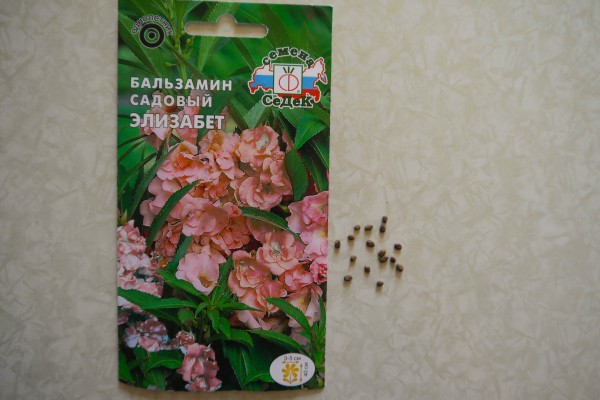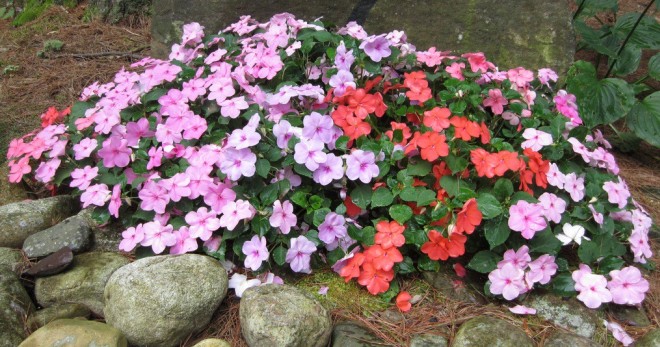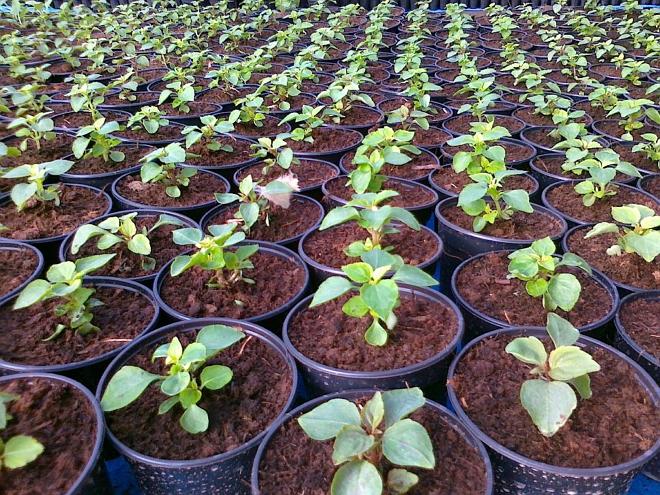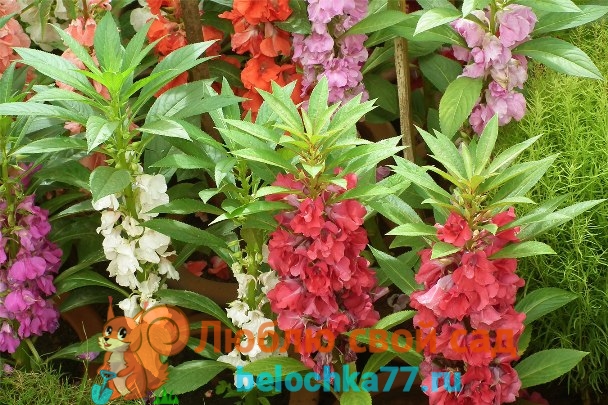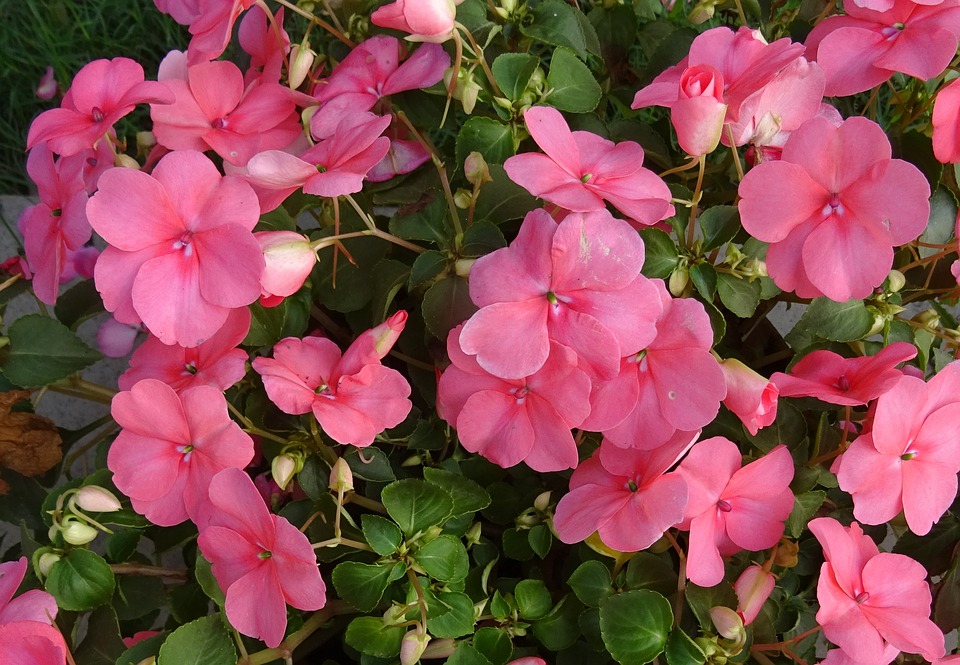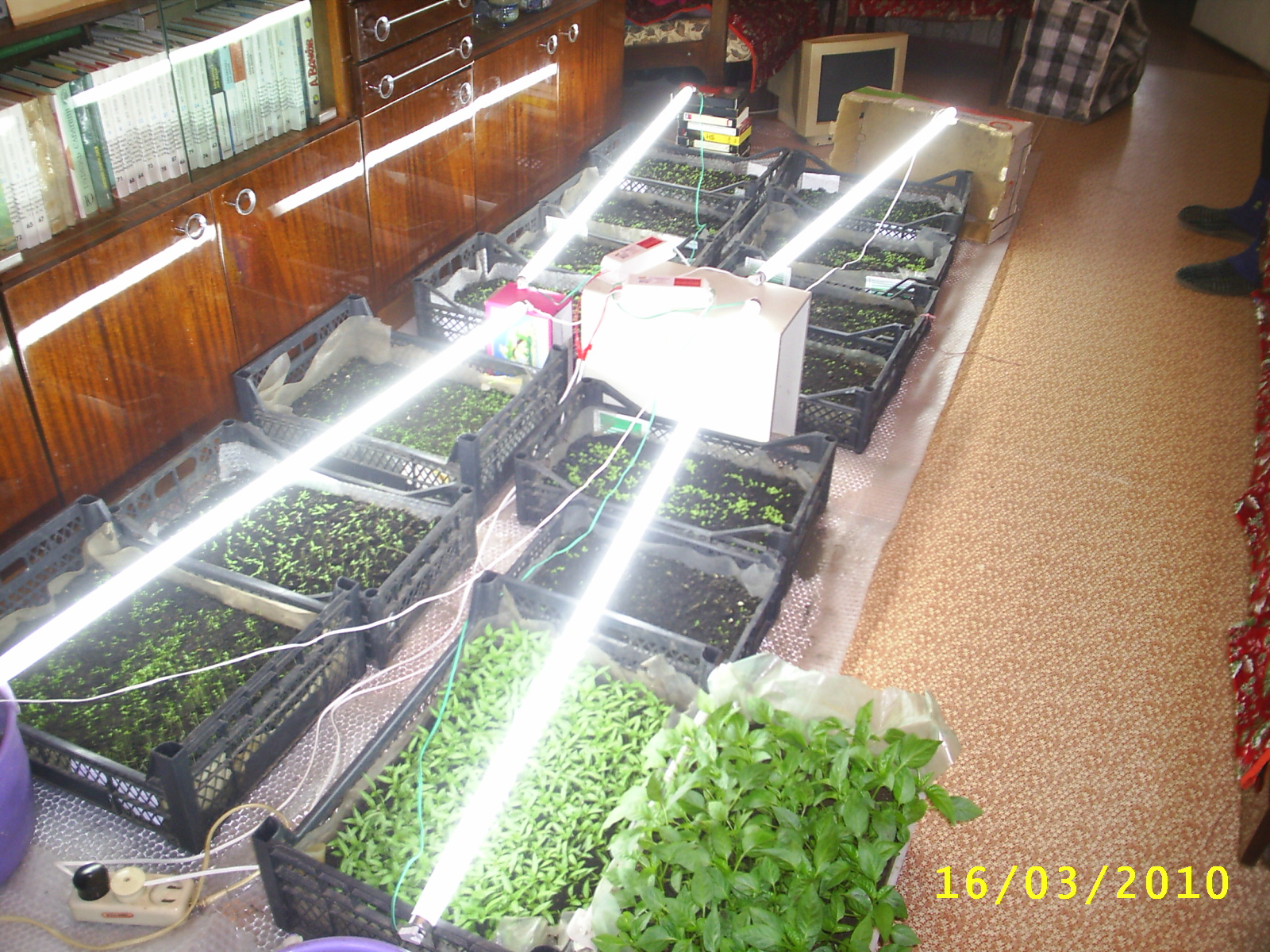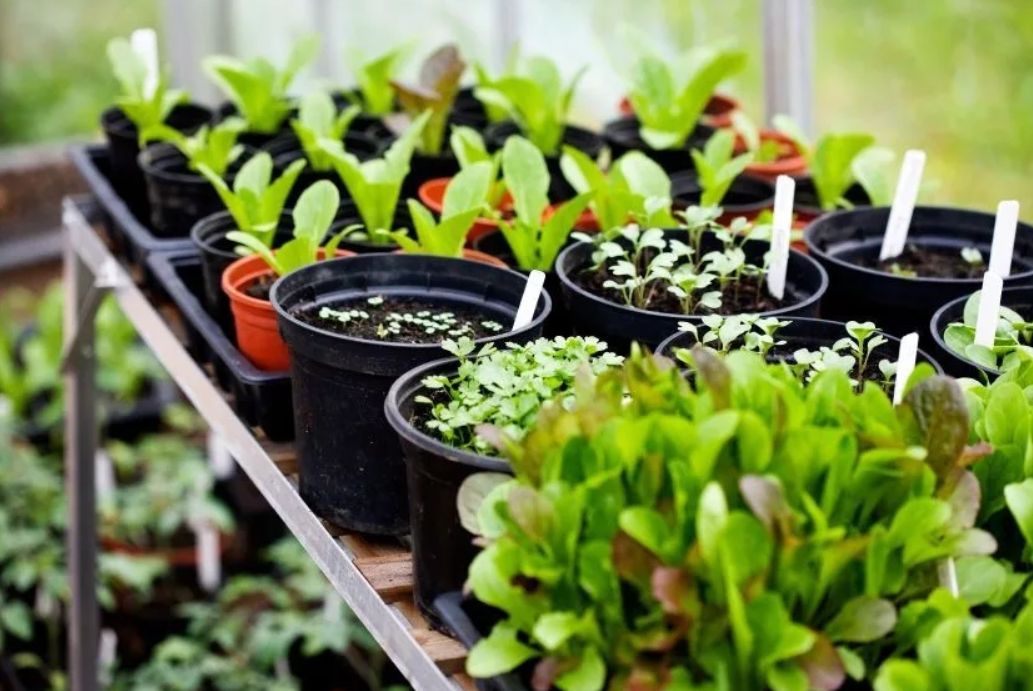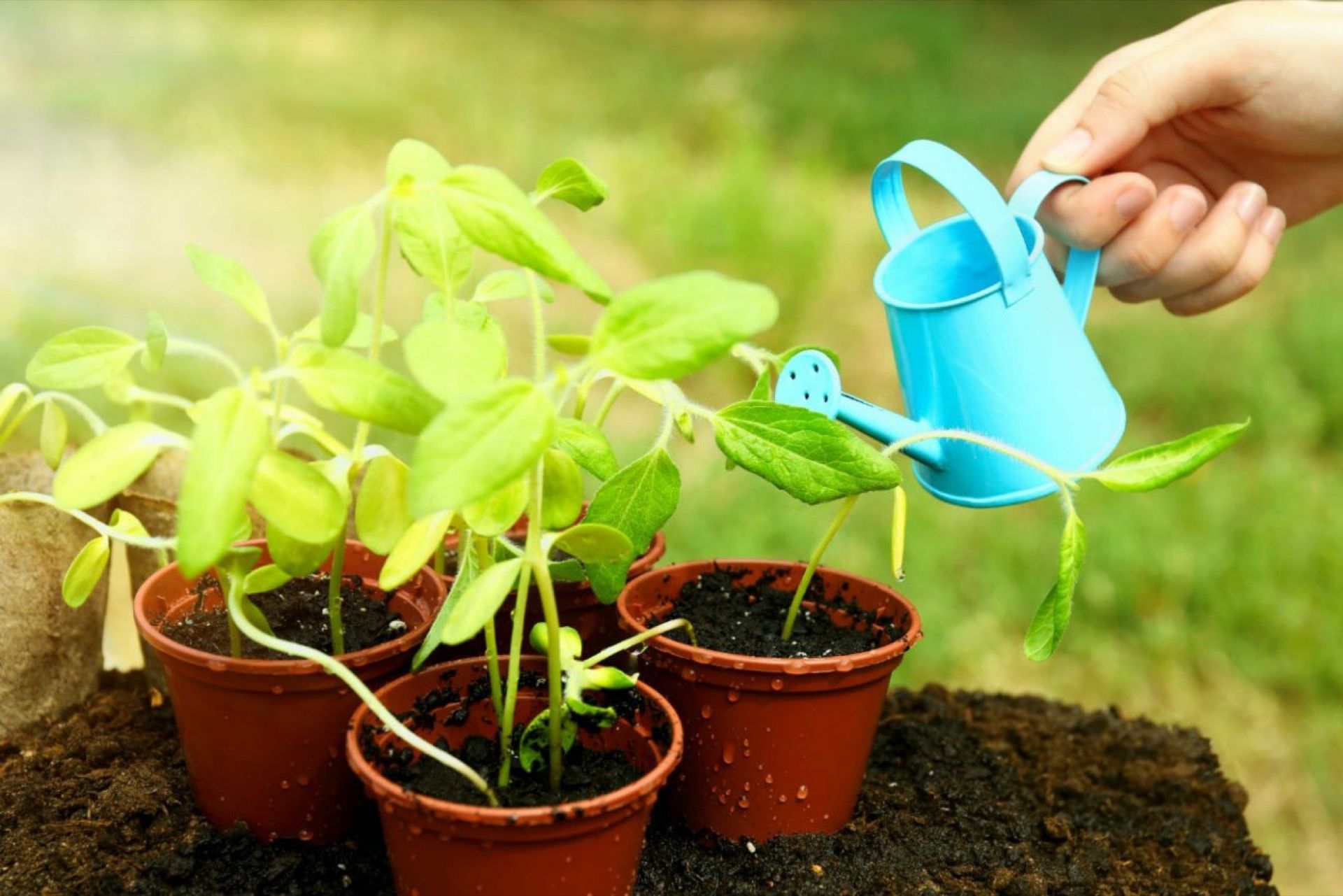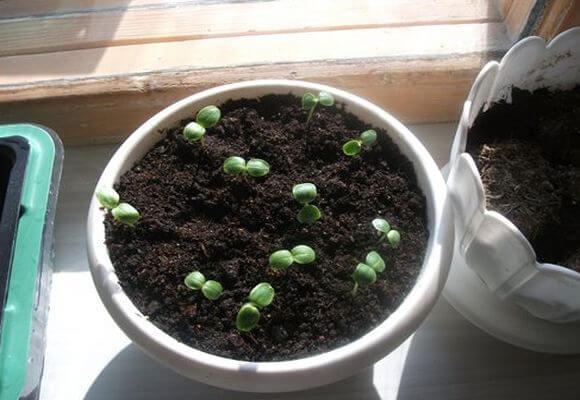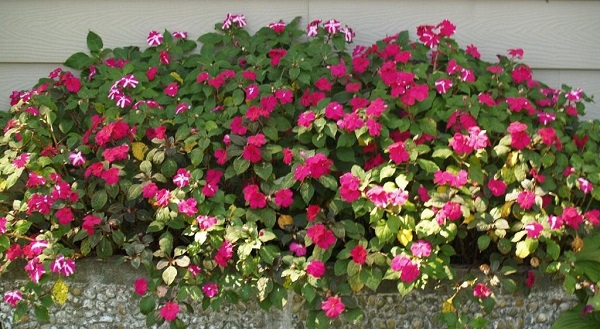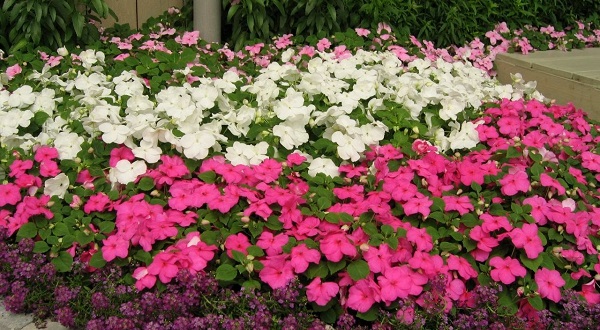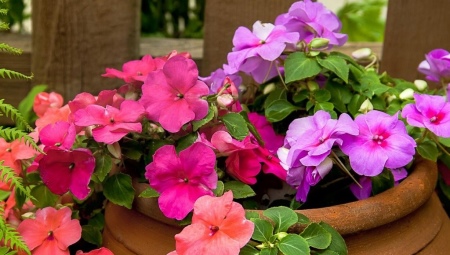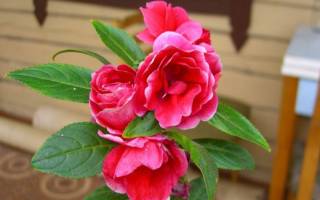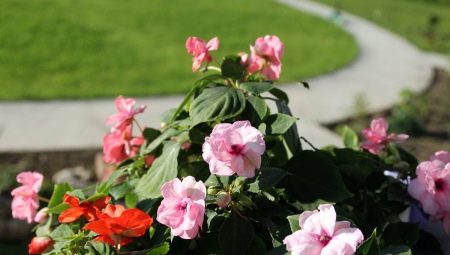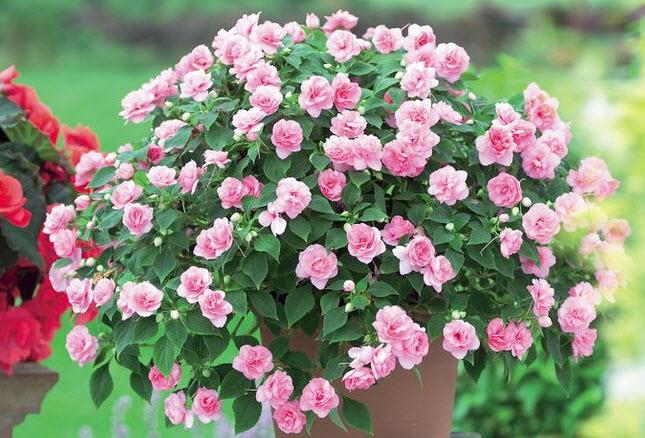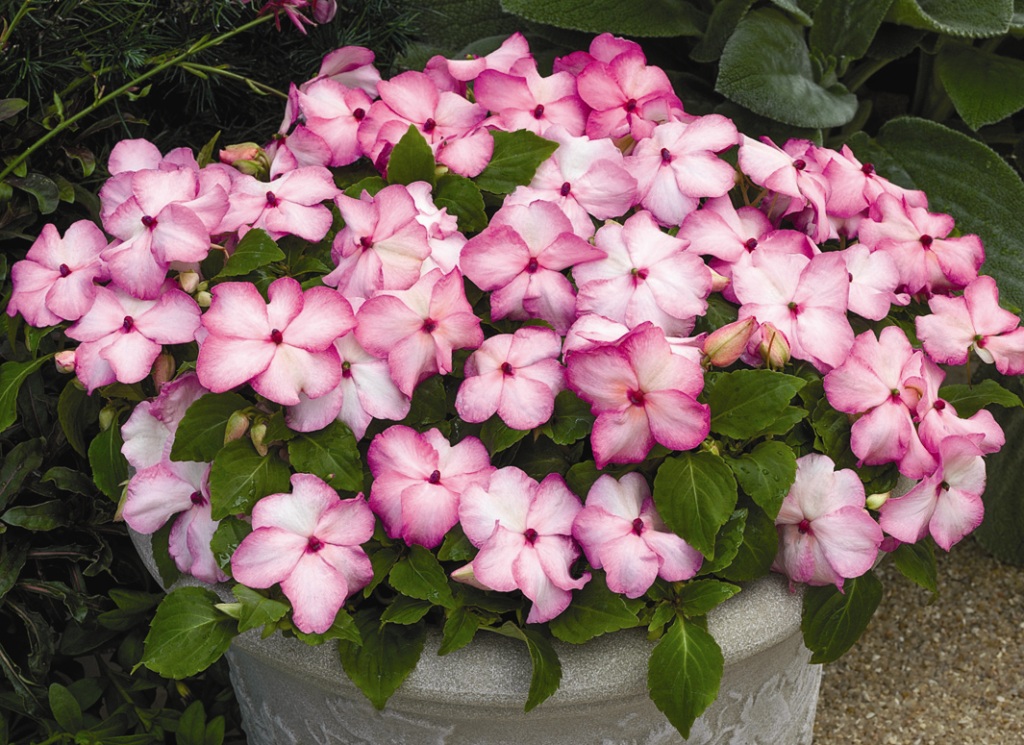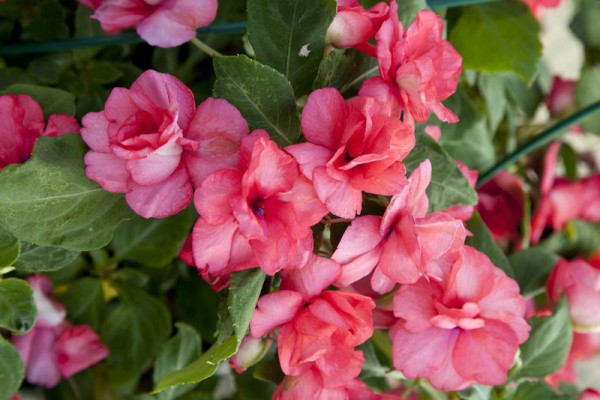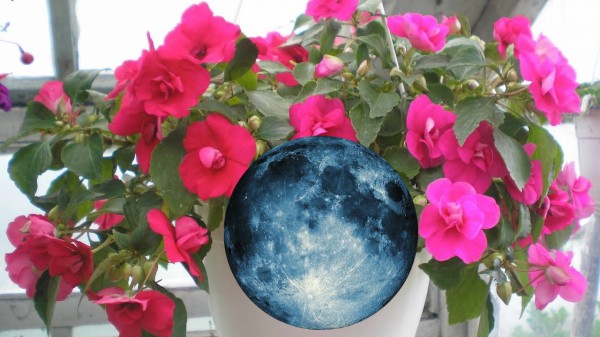Garden balsam: plant description
 This plant is also found in the wild. There are also many varieties bred by breeders. Therefore, you can find stunted bushes, barely reaching 20 cm, and plants 70 cm high (and sometimes from 1.5 to 2 m).
This plant is also found in the wild. There are also many varieties bred by breeders. Therefore, you can find stunted bushes, barely reaching 20 cm, and plants 70 cm high (and sometimes from 1.5 to 2 m).
The second difference between the varieties is the color colors. Nature has practically applied the entire range of shades, which allows you to decorate the site with a bright patterned "carpet". The same variety of colors is observed in foliage - from bronze-purple tones to green.
Inflorescences have a pyramidal or spherical shape. Otherwise, the characteristics of culture in the species are the same:
- it is a long-flowering bush;
- its branchy stems are smooth, juicy, but brittle at the nodes;
- balsam is characterized by foliage;
- the length of the lanceolate (sometimes oval) plates ranges from 8-12 cm;
- fleshy, with jagged edges, the leaves on the stem are arranged alternately;
- large, irregularly shaped inflorescences "sit" in the leaf axils.
Budding occurs at the end of spring, and the fragrance of the flower bed stretches until mid-autumn. Then, oblong five-chambered achenes are formed on the bush. When the time comes to eject seeds, they scatter around the area within a radius of 2 meters. But a mature box can react with a similar action to the slightest touch to it. Therefore, the flower received another name - "Impatient".
Classification
Garden balsam is divided into 3 main groups:
- traditional plants with spreading branches; they are characterized by green foliage and red, pink, white shades of flowers;
- medium-sized compact hybrids with purple, orange, pink, red, white inflorescences;
- New Guinea hybrids with variegated leaves.
Among each of the species you can find one- and two-colored plants, as well as terry plants, which, in turn, are divided into pink, camellia and carnation-like.
According to the direction of growth of branches, balsams are divided into erect, bush, ampel. Among low-branching plants, bouquet-bush (up to 40 cm high) and dwarf (up to 25 cm) stand out.
Popular varieties of balsam
 Waller's balsam
Waller's balsam
Waller's balm. Medium-sized compact bush with a lush, spherical crown and bare, strongly branching stems. Shiny thin leaves have different colors (depending on the hybrid). Large double or single flowers form on the tops of the stems and vary in shades from white to purple. There are two-color varieties.
 Tumbler Salmon
Tumbler Salmon
Tumbler Salmon. Refers to ground cover with a large number of branching shoots. Can develop ampelous in suspended flowerpots. Large diverse inflorescences delight the eye with bright colors throughout the year, if grown indoors.
 Tom Tumb
Tom Tumb
Tom Tamb. The highly branching bush reaches a height of 25 cm. Large double inflorescences are formed on it. Stems are well leafy with delicate plates.
 Camellia
Camellia
Camellia. An excellent variety for mixborders and discounts. In comfortable conditions, the erect stem grows up to 1 m.Gives beautiful large double flowers. It is grown exclusively by seedlings, as it is afraid of spring frosts.
It is worth paying close attention to the New Guinea group of hybrids. These are compact bushes with flowers of various colors.
Plants tolerate drought well, adapt well both in sunny meadows and in the shade. They are characterized by the continuity of flowering.
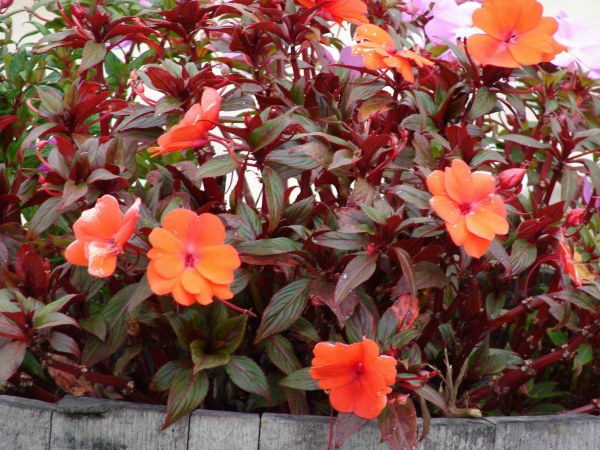 Balsam New Guinea
Balsam New Guinea
At home and in greenhouses, the species is grown as a perennial.Among the popular varieties are "King Kong", "Super Elfin", "Rosette", "Tango", "Symphony", "Fiesta", "Java".
How to grow a statice: step by step instructions
To sow a statice and grow this beautiful flower, it is necessary to carefully and correctly organize the process of sowing seeds. This takes some time, since all activities are divided into several stages.
Seed preparation
Kermek seeds have a very dense shell, through which it is rather difficult for sprouts to break through. Therefore, before sowing, it is necessary to grind the grains, but this should be done very carefully, using soft sandpaper. After that, it is recommended to additionally soak the seeds in Epin's solution for 5-6 hours. If this is not possible, they can be placed in damp sawdust for several days.
Choice of capacity
You can grow statice in boxes, containers or cassettes of any shape and size. If you plan to grow a flower as an indoor ornamental plant, plastic cups or flower pots are used for this purpose.
The soil
In a specialized store, you can buy ready-made land for growing Tatar lemongrass. It is also really possible to make it yourself. For this, river sand and leafy earth are taken in equal proportions and mixed well. Before packaging the substrate in containers, it is recommended to heat it a little in the oven, and then moisten it generously with water.
Sowing seeds and care
When all the stages of preparation have been carried out, you can proceed to sowing kermek. Basic steps:
- Put out the seeds, take out the containers. Sprinkle the calcined soil with potassium permanganate for disinfection.
- Moisten the soil, spread the seeds at an equal distance from each other. Sprinkle lightly with soil on top.
- Cover crops with foil or put glass on top of the container. Do not remove until the first shoots appear, which will appear in about 21 days.
- Seedlings must be regularly ventilated. We must not forget about the careful loosening of the soil.
- Seedlings are irrigated by irrigating the soil. This should be done with a sprayer, avoiding liquid getting on the leaves.
- When stems with 2-3 strong leaves appear in the container, the seedlings can be dived into separate cups.
Seedlings must be hardened before diving to a permanent place of growth. To do this, the containers should be taken out into the street, gradually increasing the time of their stay there. After that, the seedlings can be dived into the ground.
It is allowed to sow statice seeds directly into open ground. This process is not much different from sowing seedlings, except for the timing of planting and the need to use additional funds to place seeds at an equal distance from each other.
Seedling care
The first shoots will appear by the end of the 3rd week. During this time, it is necessary to thoroughly ventilate the artificial greenhouse by opening the bag and spraying the seeds with water from a spray bottle. In the absence of natural light sources, the plant should be illuminated with a special lamp.
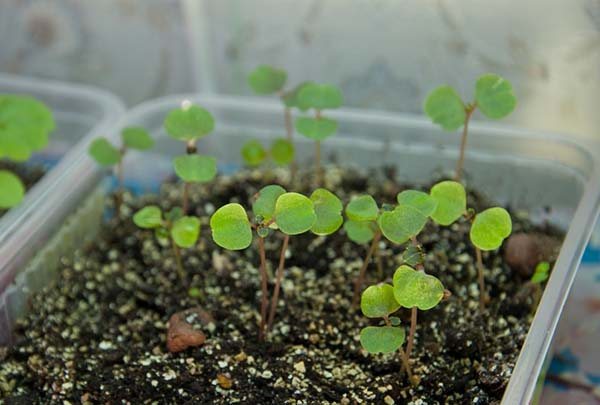
After the emergence of seedlings, the roots of the plant must be sprinkled with a small amount of earth, remove the bag and plant the seedlings in different containers. At the same time, it is necessary to change the watering system of the plant. It is best to place the pots on trays and fill them with water daily. For planting young plants, it is best to use plastic cups with drainage holes and a layer of expanded clay at the bottom. Home care for balsam is very simple.
note
Lack of light can lead to unnatural elongation of young shoots. To prevent this, during the picking process, the lower parts of the long stems are buried deeper. The plant should be dived immediately after the shoots appear.
Balsam develops rapidly at home, the plants begin to branch out and soon turn into small fluffy bushes.It is better to pinch the upper part of young plants with special scissors. In this case, the shape of an adult plant will be more accurate.
Seed Sowing Timing and Growing Strategies
Balsam prefers a fairly late planting. This plant is characterized by a shortened growing season, so sowing can be carried out in April-May. To obtain longer flowering plantings, balsam is sown in several waves. For example, in order to get the flourishing touchy Waller or New Guinea hybrids in May, the first crops can be carried out as early as January.
Impatiens can be grown both by the classical seedling method and sown to obtain planting material in hotbeds and greenhouses. With the first option, sowing can be started in March, but in greenhouse conditions, touch-ups are sown not earlier than mid-April.
Garden balsam
Balsam works well with other annual flowers.

Balsam is very fond of abundant watering.
Balsams are not particularly demanding on lighting and can grow in partial shade or in the open sun. But too intense sun rays can negatively affect the flowering of the plant, so it is better to plant it on the east side. There are no special requirements for the soil either, but it is clear that the more fertile it is, the more extensive and beautiful the flowering will be.
Balsam loves warmth, therefore, even at a temperature of + 8 ° C, the plant can get sick and die. For this reason, planting in open ground is carried out during a period of stable high temperatures.
To make the balsam grow quickly, it needs to be watered regularly. This plant loves moisture very much, therefore, in drought conditions, its shoots can quickly wither.
To ensure long flowering, it is recommended to feed the balsam once every 2 weeks. It is best to use foliar dressing, but nitrogen fertilizers should be discarded.
Balsam is prone to insect damage, so it must be sprayed to prevent the appearance of ticks.
To do this, you can use tobacco infusion, as well as infusion of onion husks, garlic and other preparations of natural or chemical origin.
Optimal conditions for growing statice
 Synonyms for the name of the statice - kermek, sea lavender, white lemongrass or immortelle
Synonyms for the name of the statice - kermek, sea lavender, white lemongrass or immortelle
Gardeners appreciate the statice for its simplicity in growing conditions. In order for it to grow well and bloom profusely, it is necessary to provide it with a favorable environment.
№
Condition
detailed information
1
Lighting
Limonium prefers sunny locations. Daylight hours for normal flower growth should last at least 13-15 hours.
2
Priming
Statice should be sown in sandy soil or loose limestone
The soil must provide good moisture circulation and air penetration, otherwise the culture will die.
3
Humidity
It is important to make sure that the moisture intake is abundant, but rare. And this process should take place at equal (if possible) intervals of time
And if the statice is planted in open soil, then watering is an additional source of moisture, since usually during the flowering season it has enough water that enters the soil with precipitation.
4
Drop off location
The statice will feel best in a rock garden, rockery, or in a tub on the terrace. The main thing is that the container is filled with a high-quality and well-balanced substrate.
5
Temperature
The optimal temperature values for the growth of Schisandra tartar are considered indicators from 16 to 20 degrees. But it should be noted that the plant is cold-resistant. It is not afraid of even severe frosts and can withstand temperatures below 30 degrees.
That is, the pots with crops should be covered with polyethylene or covered with glass. When the first shoots appear (this process takes about 10-18 days, sometimes longer), then the greenhouse must be opened. This is necessary for hardening the seedlings.
How to plant with seeds?
Many varieties of balsam are planted with seeds for seedlings. A good result is obtained using seeds from Siberia, Kuban and New Zealand seed material. The most popular of them are: "Tom Tamb", "Camellia", "Super Elfin".
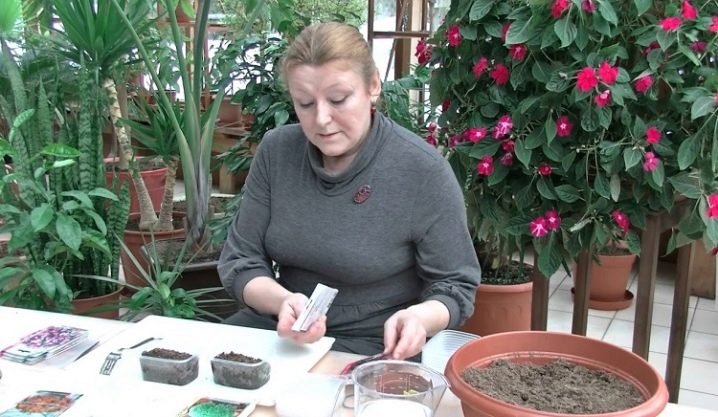
"Tom Tamb"
This variety has a highly growing bush and large flowers. The variety is suitable for the formation of flower beds, lawns, flower beds, outdoor vases. The height of the Tom Tamb variety usually does not exceed 25 cm.
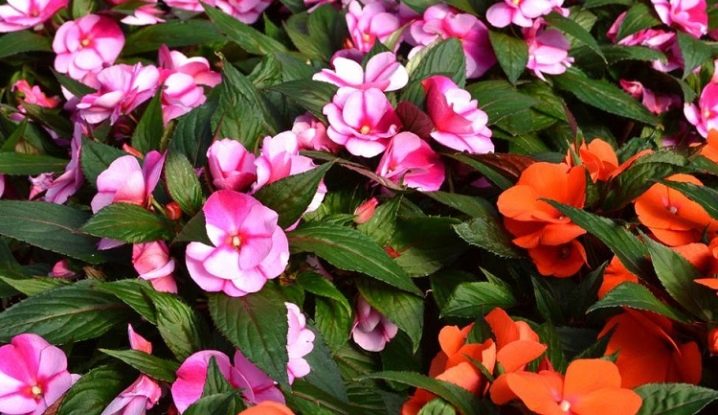
"Camellia"
One of the new varieties of garden balsams, which looks very impressive and features large double flowers. Often planted in mixed beds. The height of the bush reaches 25 cm, and the diameter of the flower can reach 4 cm.

"Super Elfin"
This is a dwarf balsam variety, which is known to many as "Vanka wet". The variety is distinguished by its unpretentiousness and long flowering. Before sowing balsam seeds of any of the varieties for seedlings, you should properly prepare the soil. There are several options for its preparation.
For example, mix 1 part vermiculite, 1 part sand, 1 part leafy earth and 2 parts low-lying peat. You can also take only peat and vermiculite in equal shares.
At the same time, it is not necessary to adhere to the exact proportions, but it is important that the substrate is loose, absorbs water well and allows air to pass through.
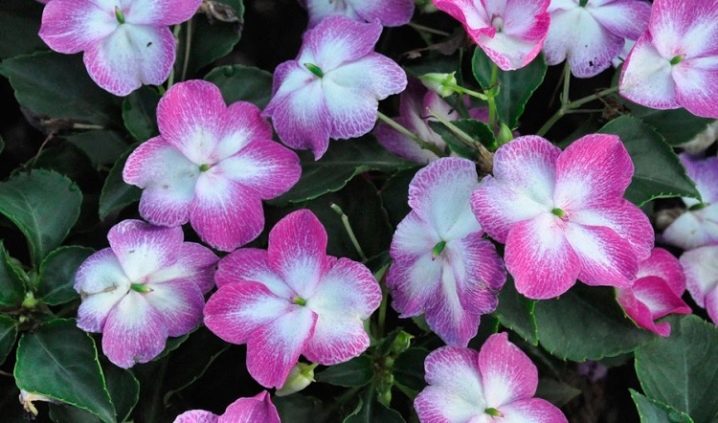
Then you can proceed directly to planting seeds.
- The seeds must be processed for several minutes in a weak manganese solution.
- Then they are soaked for 1 day in warm water.
- The sowing tray must be at least 8 cm.
- The bottom of the container must be perforated to drain excess liquid.
- The bottom of the tank is laid out with a drainage layer - expanded clay or fine gravel. The height of the drainage layer is 2 cm.
- Then prepared soil is poured into the container.
- To disinfect the soil, one day before planting, it is calcined in an oven or spilled with "Fitosporin".
- Seeds are deployed on the soil surface at a distance of 3-4 cm from each other. You should not sprinkle them on top with earth, because light is required for their germination.
- Then the already sown seeds are sprayed with water using a spray bottle.
- Above, a container with sown balsam seeds is covered with glass or film, constructing a mini-greenhouse.
- The container with seeds is placed in a warm place and periodically ventilated by opening the film or moving the glass.

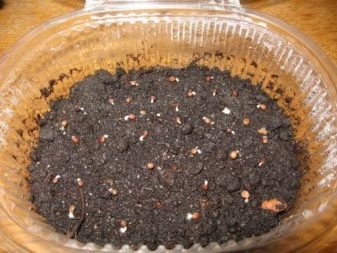
If there is not too much seed, it can be sown into peat tablets. After disinfection and soaking of seeds, planting is carried out as follows.
- The tablets are saturated with moisture until they swell completely.
- After that, seeds are sown on the surface of the soil one by one, they are not buried in depth, but simply gently pressed against the substrate with a toothpick or a match.
- Then the container is covered with plastic wrap and placed in a warm, bright place, avoiding direct sunlight.



